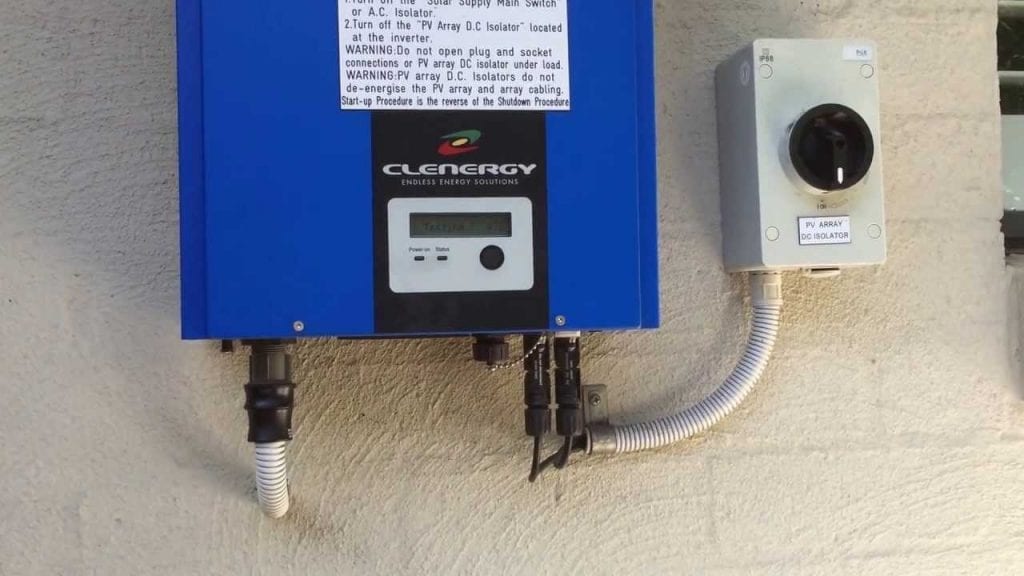 The Clenergy SPH range of solar inverters can develop a number of different faults and when a fault is present an error message will be displayed on the screen and usually the fault light would be lit. The below is a list of error messages, explanations on the error or fault and a list of possible actions to take to resolve the issue. If your Clenergy SPH solar inverter is showing a fault where the possible action to take is shown in bold letters these actions should be carried out by a qualified electrician.
The Clenergy SPH range of solar inverters can develop a number of different faults and when a fault is present an error message will be displayed on the screen and usually the fault light would be lit. The below is a list of error messages, explanations on the error or fault and a list of possible actions to take to resolve the issue. If your Clenergy SPH solar inverter is showing a fault where the possible action to take is shown in bold letters these actions should be carried out by a qualified electrician.
For more information on Clenergy solar inverters including Clenergy SPH inverter datasheets, manuals, fault codes etc. click here.
Here are some more Clenergy SPH Solar Inverter Error Messages and explanations that you may see on its screen.
|
Fault |
Display |
Possible Actions |
| System | No Utility | 1.No grid voltage. Check the grid voltage by multi-meter. 2.Check grid connection, such as wire and connector to the inverter. 3.Check breaker between inverter and grid; if it is tripped, DO NOT CLOSE again, get an electrician to check the wiring and inverter. |
| Grid Fault | 1.Wait for grid power to return to normal. If the grid returns to normal, the inverter will start again automatically within 5 minutes. 2.Check the grid voltage and frequency by multi-meter. Make sure grid voltage and frequency meet the specifications. 3.Contact your inverter service representative to discuss adjusting the operating range, if permitted by the electricity provider. |
|
| Impedance Fault | 1.The grid impedance is higher than the permissible value. 2.Wait for grid power to return to normal. If the grid returns to normal, inverter will start again automatically within 5 minutes. 3. Check the wires between inverter and grid. For high impedance connections, get an electrician to increase the wire size. 4. Contact your inverter service representative to discuss adjusting the operating range, if permitted by the electricity provider. |
|
| Isolation Fault | 1.Check the impedance between PV (+) & PV (-) and earth ground. The impedance must be larger than 8M . If the impedance is low a ground fault may exist in the PV array or wiring. Contact your PV array service provider or electrician. 2.If above actions do not fix the problem, the isolation detection circuit may be faulty. Contact your inverter service representative. |
|
| Ground I Fault | 1.This is caused by too high ground current. 2.Disconnect the inverter from the grid power. Check the AC wiring and connection system. 3.After the cause is cleared, reconnect the grid power. Check the status of the inverter. 4.If above actions do not fix the problem, the GFCI circuit may be faulty. Contact your inverter service representative. |
|
| Inverter Failure | Over Temperature | 1.The internal temperature is higher than specified normal value. 2.Reduce the ambient temperature by shading or ventilation improvements or move inverter to cooler place. 3.If this is not effective, a temperature sensor may be faulty. Contact your inverter service representative. |
| PV Over Voltage | 1. Check the PV open-circuit voltage. This should be less than 500VDC. 2. If the PV voltage is much less than 500VDC (e.g. <430V), measure the DCV by multi-meter, compare the readings on meter and LCD. If the readings differ by >5%, contact your inverter service representative. |
|
| Device Fault | 1.This is caused by an inverter malfunction. 2.Disconnect PV (+) or PV (-) from the input, start the unit again. 3.If it does not work, contact your inverter service representative. |
|
| Consistent or Mismatch Fault | 1.This is caused by inconsistent values between the main (master) and redundant (slave) controllers of the inverter. 2.Disconnect PV (+) or PV (-) from the input, start the unit again. 3.If this does not work, contact your inverter service representative. |
|
| Error Message | Explanation | |
| No Utility | Grid voltage is not detected | |
| PV Over Voltage | PV voltage is too high | |
| DC Bus High | Internal DC bus voltage is too high | |
| DC Bus Low | Internal DC bus voltage is too low | |
| Over Temperature | Internal temperature is too high | |
| Grid Fault | Grid voltage or frequency is out of range | |
| Device Fault | Internal fault with inverter circuits | |
| Isolation Fault | PV panel ground isolation problem | |
| Impedance Fault | Grid impedance fault (or grid disconnected) | |
| Ground I Fault | Grid output ground leakage current too high | |
| Relay Failure | Grid output relay failure | |
| DC INJ High | Grid DC injection too high | |
| Ref 2.5V Fault | 2.5V reference voltage internal circuit fault | |
| DC Sensor Fault | Grid DC current sensor internal fault | |
| GFCI Fault | Ground Fault Current Interrupt fault | |
| Sci Fault | Internal Master/Slave communication fault | |
| Consistent Fault | Internal Master/Slave value mismatch fault | |
| CPU Ver Mismatch | Internal Master/Slave firmware incompatible | |
| EEPROM Fault | Internal non-volatile memory fault | |
| Grid V Mismatch | Internal Master/Slave grid voltage mismatch | |
| Grid F Mismatch | Internal Master/Slave grid frequency mismatch | |
| Grid Z Mismatch | Internal Master/Slave grid impedance mismatch | |
| GFCI Mismatch | Internal Master/Slave ground fault value mismatch | |
| DC Curr Mismatch | Internal Master/Slave grid DC current mismatch |

If you want to find out more about the Clenergy SPH solar inverter error messages the full details can be found in the Clenergy SPH inverter manual section on Troubleshooting. If the resolution procedure fails to fix the issue and the inverter is still within the 5 year warranty period the best thing to do is try to contact the company who installed the Clenergy SPH inverter.
If your inverter is outside the 5 year warranty period you’re going to need a solar power expert to help you rectify the issue. If you’re in the Gold Coast or Brisbane area contact Gold Coast Solar Power Solutions here, we can help you have your solar power system back in action as soon as possible.
For more information on Clenergy solar inverters including Clenergy SPH inverter datasheets, manuals, fault codes etc. click here.
Got A Question About Solar Power? Click Here For Answers!
- Can you add more solar panels to your solar power system?
- How much power can you expect from your solar power system?
- Do you know how to read your Energex solar power meter?
- How to make the most of the 44c feed in tariff
- How to make the most out of a low feed in tariff




